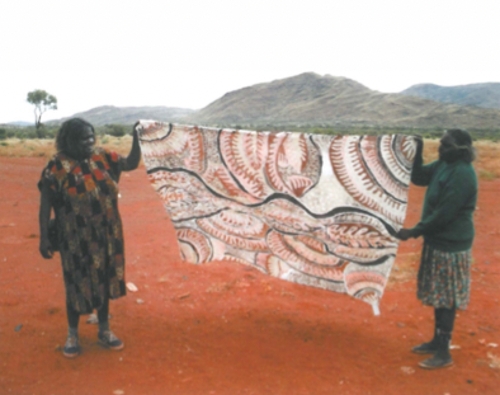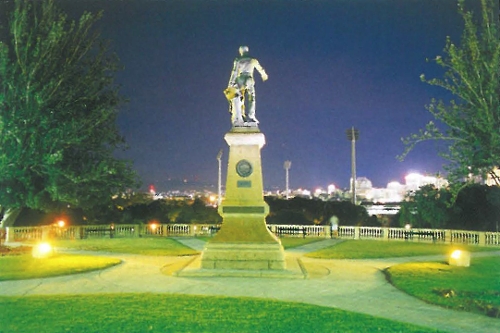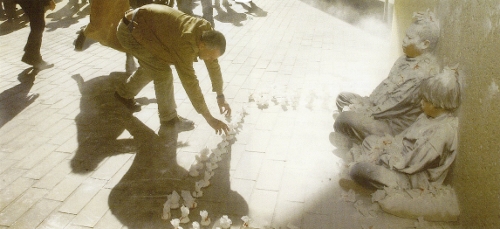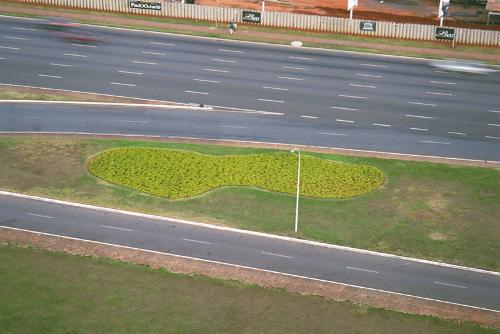Search
You searched for articles tagged with Environment ...

Sue Richter. On Colour: Whiteblack Red
24HRArt, Darwin 9 July - 7 August 2004 Araleun Arts Centre, Alice Springs 3 April - 9 May 2004

Three Colours: Gordon Bennett and Peter Robinson
Heide Museum of Modern Art, Melbourne 8 April - 4 July Travelling to Victoria, Tasmanaia, Queensland, NZ July 2004 - July 2006

Barking Up the Wrong Tree
Carnegie Gallery, Hobart 10 June - 4 July 2004 Curators: Stephen Mori, Felicity Wade & Raquel Ormella

Octopus 5
Raafat Ishak, Horst Kiechle, Kaji Ryui, Grant Stevens. Curator: Nicholas Chambers Gertrude Street Contemporary Art Spaces 9 July - 21 August 2004

Philip Wolfhagen
The Inner Edge Academy Gallery, University of Tasmania, Inveresk 14 June - 9 July 2004

Peter Timms' 'What's wrong with contemporary art'
Blak Insights Queensland Art Gallery 3 July - 30 October 2004

Signs of the Times: Stephen Page, Sacred Symposium, Adelaide Biennale
Stephen Page is the first Artistic Director of the Adelaide Festival of Arts to be indigenous and his program for 2004 includes indigenous works but perhaps not many more than most Adelaide Festivals, which have always had a significant indigenous component. Yet there is a sense that the commissions that Page has initiated represent a maturity in approach and development that signifies a watershed for Indigenous culture in Australia. Page expects it to be optimistic, philosophical, constructive, to reflect on the fusion of the old and new without bastardization.

The Dave Inside
About the work and fame of Las Vegas based art writer Dave Hickey. Like all icons Dave comes with a portable, pocketable, mythology. A pungent blend of his own statements, press hype, rumour and dubious speculation.

Virtual Adelaide
One of the leading interactive groups to come out of Britain is the Blast Theory who are making interactive gaming projects, installations and mixed reality projects in various major cities of the world. They were based in Adelaide from January to March 2004 under the South Australian Premiers Thinkers in Residence Program in partnership with various other major Australian art corporations. Through the use of real and virtual city cityscapes there is an overlapping of concepts of time and space, with a focus on ideas of absence and presence amongst players online and those on the streets.

Beyond Adelaide
Brook looks at the role of geographic location throughout the ages of art theory and practice. The metaphor of adverse location prompted some baroque theorising about the metropolis as contrast-partner to the provinces...with the onset of neo-conservatism and the supervenience of economically rational accounts of virtue and of value the idea that art is peculiarly sensitive to location because it is more cultural than clothing and footwear came under challenge..
. Addressed in a context that concerns the locality of Adelaide, and beyond.

Young South Australian Art
This article is about hip young artists working outside the field of contemporary art.
Even if the changes of the last forty years have meant that liking things for being cool and fashionable has generally lost its polemical significance, my sense is that this still may hold some currency with regard to the specific condition of contemporary art in South Australia
. Strickland examines the work of South Australian artist Magosia Miow.

Wet Culture - Playing With Codes
Melentie Pandilovski, the Director of the Experimental Art Foundation in Adelaide, sees the current manifestation of the word experimental in Experimental Art Foundation as relating to biotechnology, consciousness and the places taken up by artist in scientific places where experiments are the usual tasks at hand. In a move away from dry hard-wired technologies the last five years has seen a rise of wetwork and a new subculture within science as artists find new roles in scientific laboratories and ask fresh moral, ethical and aesthetic questions.

Stories: Past, Present and Future
Franchesca Cubillo, the Artistic and Cultural Director of the National Aboriginal Cultural Institute, has a broad cultural background with Spanish Catholic and Filipino cultural infuences fusing seamlessly with her Aboriginal heritage. Aside from her administrative and managing roles at the institute she is also a painter and photographer. Maughan looks at Cubillos life and work as it is shaped through an appreciation of the importance of family and community.

Isolated Interventions
This article explores the artistic and economic viability of living and working in South Australia, a state with less than 400,000 people, most of whom reside in the south-eastern corner.
Theres enough professional isolation here to remind us that were living in a world where art is not a self-evident virtue
. As a result of living in the geographic margins, artists require considerable ingenuity, flexibility and lateral thinking in order to sustain a viable practice.

In the Far North-West
Colin Koch is the coordinator of Ku Arts, the artists representative and development body, a role which requires him to make the journey up into the northern regions of South Australia, land belonging to the Anangu people, once every six weeks. Koch discusses the significance of Ku Arts: some of the hurdles they have had to overcome and the subsequent milestones this regional indigenous arts centre has acheived.

Can Culture Save the River and Wetlands?
This question 'can culture save the river and wetlands'was put to a debating panel at the annual conference of Country Arts SA in October 2003. The river in question was the Murray. This article takes up some of the important issues surrounding environmental degredation and focuses on the SunRise 21 Artists in Industry Project which saw the collaboration of artists and organizations working together to establish a mutual relationship between arts and the environment.

The Second Experiment: Floating Land 2003
Floating Land 2003 was an event held as part of Noosa Regional Gallerys second major biennial site-specific art project that ended in high drama at 3am on the top of a mountain and one that unexpectedly created a new lobby group. The emphasis for this project was on experimentation both in terms of the art and the notion of what consitutes an event/festival that takes place over a period of time.

Ara Irititja: Protecting the Past, Accessing the Future - Indigenous Memories in a Digital Age
White fellatechnology was once considered a threat to Anangu culture and identity, but when iMacs, data-projectors and printers turned up in Anangu communities, they attracted a great deal of interest and excitement. The above mentioned title was an exhibition that opened at the South Australian Museum in October 2003 and comprised of three remarkable multimedia interactive databases which stand to offer unique opportunities to investigate pitjantjatjara and Yankunytjatjara peoples history and culture.

Community Arts and Artists in the Community
The Parks Arts & Functions Complex is situated in the Parks Community Centre in the Western suburbs of Adelaide, a region made up of many disadvantaged and minority groups. Weekly and fortnightly groups meet to explore different mediums and creative processes, and working without the assistance of a tutor means they rely on each other to develope their skills. The social benefits of these groups are often as important as the creative concerns. The centre invites guest artists to run various workshops to help sustain this interaction amongst members of the community.

Transfiguring ACMI
The Australian Centre for the Moving Image (ACMI) is now just a little over a year old. Housed in a purpose-built venue at Federation Square in Melbourne , ACMI is home to two multi-format cinemas, a variety of exhibition, education and production zones and the Screen Gallery, the largest of its kind in the world and, arguably, the jewel in ACMIs crown. Gye looks at the recent success of the new Screen Gallery and the future direction of ACMI.

Sacred Food: Elizabeth Nyumi
Like many of the people at Balgo, Elizabeth Nyumis early life was a nomadic existence with her family group on the Canning Stock Route. Whe her mother died she walked with her father into the old Catholic mission at Balgo. She began painting for Warlayirti Artists in 1988. Recently a very successful painter, she was invited to show at the 2004 Biennale of Sydney. OBrien examines Nyumis life and work.

The Real Thing: Recent Art of Derek Kreckler
The twenty-first century, it seems, will not be the age of manifestos. Like advertising campaigns and the design of cars and other consumer items, contemporary art has started to look the same....there is no agenda, no politics, no historical claims
. As McLean states, for Derek Kreckler, the point of being an artist today is not how well you resist this condition, but how well you can bend it to your own ends. Krecklers work is here positioned in a postminimalist rather than a postmodernist framework.

The Museum is the Message
The fifteen artists involved in Inside SAM's Place all acknowledge the shared language of art objects and museum artefacts.

Distance in our Lives
Exploring collaborations and their relationship to crossdiscipline and cross-cultural art practice is a key interest of Parallelo, South Australia's leading edge performance company. For over 18 years Parallelo have experimented with fusions of culture, media and artform as mediums for artistic expression and for new audience access.

Smart Strategy for Art Education
The marketing of senior secondary art achievement in South Australia, which has seen a rise in popularity in Year 12 art exhibitions, cannot be taken as proof of the depth and sustainability of visual art education in schools across all levels.

The Chapman Brothers
UK artists Jake and Dino Chapman have been the subject of public and media controversy since their emergence on the British art scene in the early 1990s. The Chapmans assert that their shock tactics are in aid of an examination of cultural taboos.

Border Zones: An Eye on the World from Sydney
According to Chapman, the contemporary understanding of a globalised world is the result of the understanding that we all share a finite physical realm: this planet. The world is no longer understood purely in terms of geographic boundaries, but cultural ones. This article looks at some of the utopian values imparted upon some of the major cities in the western world and discusses concepts of globalism and localism as they contribute to a new perception of the world around us.

A contested place: Film and land
The importance of place depends on what it means to us, what we make of it and our understanding of how it shapes us. In 2001 in the Australian film industry there was an avalanche of films, both documentaries and features, addressing issues surrounding place in the context of the relationship between black and white Australians. Six features which Hann values for their portrayal of this relationship are One Night the Moon, Rabbit Proof Fence, The Tracker, Beneath Clouds, Kabbarli-A Film About Daisy Bates and Australian Rules.

Places Not Forgotten: In Rural South Australia
The Flinders Ranges in South Australia where Malcolm McKinnon lives is a place of diminishing population, sparse landscapes and resilient social memory. It's a place that reveals itself only over time, as the stories, names and explanations for particular places and people become gradually apparent. It's a place where most of the people of the land carry memories and maps of special places around in their heads. McKinnon's aim in writing this article is to use these places and the claims attached to them by many non-indigenous people to show that they are just as legitimate as those of indigenous people.

Postcards from Victoria: Fertility from the Air
To celebrate the Centenary of Federation, Regional Arts Victoria undertook a series of art projects across Victoria. '...such fertile ground...' unfolded in two stages during the years 1999-2000, involved twelve different locations, fourteen different artists and produced some stunning images which reflected unique aspects of the places which inspired them. Participation was open to anyone going through the local affiliate Arts Council and a local artist would be appointed the task of creating an image. Artists included Maxine Salvatore, Mark Selkrip, Jenny Munday, Ken Raff and Anton Vardy.

Float or Sink: A New Direction for Art in Regional Australia
When it comes to the interpretation of place, whether it be through the language of art, economy or social relations, we are always doing so through a culturally constructed lens and at a culturally constructed moment in time. The way we represent the land affects how we use the land and our land use in terms affects the way we represent it. Wilson looks at art that is made outside the context of the art gallery or computer screen and the ongoing categorisation and separation of institutionalised art from public art. The Artists Working in Nature movement and The Floating Land project are here used in reference.

Place Works: India Flint
India Flint's textile practice seeks to articulate the cyclical connection between human existence and the patterns of nature. She researches traditional dye practices with old approaches being re-examined to generate more ecologically sustainable methods of production and uses indigenous plant forms and declared noxious weed. As the cloth absorbs colour from materials extracted from the landscape, so it becomes steeped in the landscape itself.

Place Works: Martin Walch
Over the last five years Martin Walch has been working on the Mt Lyell Project as an artist in residence with Copper Mines of Tasmania. The project is ongoing, and now consists of a number of sound recordings, animations in 2D and 3D, stereoscopic pairs in travelling cases, as well as large re-photographic works based on J.W.Beatties' Mt Lyell photographs from 1893-6.

Place Works: Bette Mifsud
The body of work shown as The Living Room (RMIT Gallery 2001) continues Bette Misfud's studies of the emotive and emblematic power of landscape imagery. The Living Room represents, in part, the cultural segregation and physical isolation Misfud experiences in rural life as a second-generation migrant. The land is continually transformed by the marking and scarring of our habitation. Thus both land and identity are in a continual state of flux.

Place Works: Bronwyn Wright
Bronwyn Wright's work has closer links to the stealth associated with graffiti artists and the flamboyant play of the theatre than to large scale earthworks. It is based on intimacy with the site, daily visits, observations of seasonal variations and an anonymous interaction of dialogue with a young sub-culture. The ruined cars which adorn the site of 'The Swamp' where Wright works are symbolic mediators between earth and technological man. The car bodies wear away, crumple and disintegrate as the land itself is torn and worn and as our own bodies tire and retire.

International Artists Space Kellerberrin Australia: WA Wheatbelt Artzone
Two hours drive from Perth is the small regional town of Kellerberrin. With a population of nine hundred people and appearing just like many other municipalities in the region, the incongruity of this town lies in the presence of the grandly named International Art Space Kellerberrin Australia (IASKA), a gallery and residency centre for international contemporary artists. IASKA was established in 1998, developing from a collaboration between two wheatbelt farmers, Tony York and Donna Dransfield, and two art professionals from Perth, artist Rodney Glick and Marco Marcon. The intention behind this double displacement is to offer both artist and communities a kind of shock treatment that will force them out of their respective comfort zones and encourage the development of new ways of approaching both art practice and notions of local identity. Visiting artists have included Salvatore Falci and Cathy Barber.

Terror Australis: Fear and Loathing in Open Spaces
When European explorers first discovered Australia, it was generally referred to as Terra Australia Incognita literally translated as Unknown Southern Land. Marshall looks at the physical terrain of this equally beautiful and dramatic region of the world via a selection of prolific Australian films which give shocking portrayals of our lifestyle here in the lucky country. Terror based films such as Dead Calm, Razorback, The Cars that ate Paris and Kiss or Kill.

Making Place in an Urban Sense
Our sense of who and where we are is continually mediated by images of the wilderness and the outback, but the real home of our species is the city. Downton is an architect determined to work through processes of ecology and community and is excited by the challenges of the city. He here examines the connections between humans and nature within the domain of a civic built environment.

Material Difference
Chandler looks at the practice of Paul Johnson and Elizabeth Frith Poole, two artists who both live in the same regional area, but convey contrasting views concerning the significance of place. For Frith Poole, time spent investigating her immediate environment has led to a more profound understanding of it, while Johnson utilises materials that are claimed as belonging to specific sites or cultures to confront assumptions concerning landscape and identity.

Spirit and Place Revisited
Spirit + Place, Art in Australia 1861 to 1996, an exhibition curated by Nick Waterlow and Ross Mellick at the Museum of Contemporary Art in 1996 in Sydney, is widely referred to as a landmark exhibition. The exhibition placed Indigenous Australian Art together with non-Indigenous Australian Art, as well as making honorary Australian artists of Joseph Beuys, Marina Abramovic, Christo and others. The exhibition encompassed ideas that were linked to issues involving the environment, ethnicity and human pain and pleasure, with relevance both locally and beyond these shores.

Living the Lie (of the land)
Due to the concentric nature of its revelations the exhibition The Lie of the Land deserved particular consideration in terms of the resonances that placement, grounding and the physical experience of the Australian landscape and environment can have on the issue of current art practice. Curator Carmen Grostal felt a personal and philosophical urgency behind the idea for the exhibition, with the title of the show responding to Paul Carter's text of the same name and was used as a way to enter into dialogue with the ideas raised in it.

Six Days in Boyd Country
When Arthur Boyd gifted his large Bundanon property to the nation in 1993, he imagined the creation of a place that would become a living arts centre where artists of all persuasions would come to find refreshment and renewed inspiration in the landscape. The Bundanon Artists Centre is housed in former farm buildings and has hosted writers, visual artists, musicians, choreographers and film-makers. Among the most celebrated are J.M. Coetzee, South African novelist, Peter Mumme, environmental composer and Dorothy Porter, Australian poet. Kronenberg also discusses the work of artist John R. Walker who was invited to participate as a senior-artist-in-residence in 2000.

Tjukurpa Wangapai - Story-Telling Place
In 1998 Margaret Worth was invited by a small group of Pitjantjatjara women to visit the Tjilbruke Gateway installation at Warriparinga on the banks of the Sturt River in Adelaide. Months later Worth visited the women to talk about making a place like the Tjilbruke Gateway. This article looks at Worth's role in helping to develop a built site which would signify as much as its natural environment did. In the process she learnt what was important to know about the land and developed her own understanding of place.

Place Works: Tim Maslen and Jennifer Mehra
Tim Maslen and Jennifer Mehra are Australians who live and work in the UK and have appropriately developed their body of work based on the experiences of disjunction one feels when removed from their familiar physical environment. Their artificial landscapes act as metaphors for the difficulty humans have in overcoming epistemological delusion and acknowledging the fact that life in the world is a unitary experience. We can see Maslen and Mehra's work as a kind of ritual to help us reconcile ourselves with our origins.

Traces of a Shared Memory
Julie Blyfield's recent work explores her family history and her own sense of place and identity through the objects that have been handed down to her from her grandparents. Her grandmothers embroidery was a specific reference point for this work, as she metaphorically 'unpicked' her designs and reinvented them through her own medium.

River Systems
The work in River Systems responds to the region Ian Tully lives in, the south western Riverina of New South Wales and the surrounding country. The intention of his work is to question the whole notion of sustainability. Tully is continually torn between the design and aesthetics of industry, and the fragility, beauty and sensitivity of our diminishing natural systems.

Your city is so ugly: Adelaide and the truth
'Your City is Ugly' was a 2002 Adelaide Fringe production devised by John Adley, Chris Barker, Julianne Pierce, Katrina Sedgwick and Daryl Watson. Page layout by Daryl Watson with text by Julianne Pierce. Architectural photographs by Daryl Watson assisted by Tim Fenton. Photographs of Madame Ivana, Vladimir and Sergei by Annette Tripodi.
Art, Architecture and the Environment
This issue of Artlink tries to flag some of the issues for designers in Australia today, and to document just some of the changes which are happening.
Art, Architecture & the Environment
The Art of Living
The place Ecopolis 2, the world's first ecocity. The time -- mid-afternoon 3rd November 2007.
Art, Architecture & the Environment
Creating Livable Places
Affecting one's city, state or country requires wit, wisdom opportunity and a sense of fun. Robert McNulty, President of the extraordinarily successful Washington based 'Partners for Livable Places' gives a thumb-nail sketch of the last 15 years of the organisation and some of the tools they have used as operational forces for action.
Art, Architecture & the Environment
Willmot Playspace Project
Willmot Play Space has taken place over a four year period and has involved the conversion of a disused football field inot a community park.
Art, Architecture & the Environment
Acoustic Futures. Sound Noise and Urban Design
Our town planners, our architects and we ourselves need to rethink the city. If downtown spaces, internal and external, are to become inhabitable, there needs to be a dramatic shift away from narrowly architectural conception of them and their functions towards an acoustic analysis.
Art, Architecture & the Environment
Women's Ideal Environments
It seems clear enough that women feel loss and the lack at the heart of the consumer society. But the creation of other riches, even in imagination, is hard to achieve....We need nevertheless to imagine other worlds, other ways - all of us- in order to sustain hope and inform desire.
Art, Architecture & the Environment
2040: A Message from the Future
The Brisbane Community Action Group CART (Citizens Advocating Responsible Transport) have recently won two awards....
Art, Architecture & the Environment
Sustainable Canberra
Australia's capital shows the way in applying sustainability to a city.
Art, Architecture & the Environment
Material Re-Creation
A new paradigm of design is starting to emerge as a result of the efforts of those members of the design community who are concerned with the extent, as well as the underplaying, of our global environmental crisis.
Art, Architecture & the Environment
Architecture and Lyndall Milani's Installations
Lyndall Milani uses sculptural installations to question the place of architecture in the landscape and within human life.
Art, Architecture & the Environment
Solar Houses: an Introduction
Faced with these complexities, it is hardly surprising that many designers find the proto-type solar house to be a preferable starting point.
Art, Architecture & the Environment
Working with Rules
We all use rules. By looking at them critically we will precipitate a dynamic evolution in our understanding and practice of designing 'with the environment'.
Art, Architecture & the Environment
Andy Goldsworthy: Everything in the City is Nature
British artist Andy Goldsworthy came to Australia for three weeks in July to work on site at Mount Victor Station east of the Flinders Ranges. During the 1992 Festival of Arts photographs of the works made at Mount Victor and an installation was shown at the Artspace at the Adelaide Festival Centre, a survey of past works was on show at Yarrabee and Goldsworthy produced a permanent work for the Adelaide Botanic Gardens.
Art, Architecture & the Environment
The Essential Gift of Ceremonies: Towards a Poetics of Scarcity
"In modern architecture we find difficulty in managing the relation between the physical presence of a building and its intimations of the mental and spiritual. Our architectural objects rarely serve as objects of intermediation between the ordinary, the physical and the present on the one hand, and the mystical, the spiritual and the abstract on the other...."
Art, Architecture & the Environment
Built Form for Well-Being, Not Just Comfort
Looks at issues of energy self sufficiency -- battery banks and photovoltaic solar collector panels.
Art, Architecture & the Environment
Aleks Danko: Day In Day Out
Two recent shows in Melbourne of installations by Alex Danko have investigated issues indirectly referring to architecture and the private and social body within the Australian environment.
Art, Architecture & the Environment
Designing from the Inside Out: Women, Design and Architecture
'Choose a woman architect - there is a difference!' proclaim a multitude of stickers all over Sydney. Constructive Women, the Sydney based association of Women Architects and Planners decided it was time for a new approach.
Art, Architecture & the Environment
Places for Souls to Play
Looks at the work of Gabriel Poole with statements by Gabriel Poole.
Art, Architecture & the Environment
Eco-design Conference at RMIT
Eco-design is probably one of the most far reaching topics to be assembled under the banner of one small hyphenated word. The linking of ecology with design is for many still a novel concept....conference held at RMIT 17 -19 October 1991.
Art, Architecture & the Environment
Response to the Climate in the Top End
It never gets really cold in the Top End. But it does get very humid during the Wet. However, simple steps in house design can make the house comfortable and you don't need fans and air conditioners.
Art, Architecture & the Environment
Artists and the Mt Leuseur Campaign
Artist's involvement in the Mt Lesueur Campaign -- 200 km north of Perth, Western Australia.
Art, Architecture & the Environment
Let There be Light and Power
Berwyn Lewis talks to solar physicist Bruce Robins. Imagine 6 billion people simultaneously turning on lights and electrical appliances. This apocalyptic drain on power would plunge us into an eternal blackout with devastating effects on the environement.
Art, Architecture & the Environment
Willunga Garden Village
Willunga Garden Village is a 20 acre allotment subdivision on a 10 acre site on the slopes of the north facing Willunga (South Australia) escarpment.
Art, Architecture & the Environment
Aspects of Earth Building in New Zealand
New Zealand is not only snake less and nuclear free but also has a tradition of earth buildings. In pre European times, Maori utilised the ground's insulating properties by partially sinking thatched roofed houses into the ground.
Art, Architecture & the Environment
Earth-Sheltered Building using Timber
Earth sheltered housing is not new. The most common way of keeping the soils at bay has been with reinforced concrete and masonry walls and roofs.
Art, Architecture & the Environment
Res B: a Design Proposal for Brisbane
In Brisbane the older suburbs are distinctive and a prime source of identity for this sub-tropical city. The timber tradition has left us a rich heritage. For this proposal we have taken an existing suburb with houses on 800m2 blocks. The houses are simple single frontal address buildings.
Art, Architecture & the Environment
Supporting Remote Places
Today's temperature will be around 37 degrees. At 6 am the relative humidity was 94%. The Monsoon winds haven't found their bearing to the north west, and the prediction is that el nino will prolong the build up this year - a late wet>
Art, Architecture & the Environment
On Empowering Clients and Collaborative Design Processes
"Never doubt that a small group of thoughtful, committed citizens can change the world; indeed, it's the only thing that ever has." (Margaret Mead)
Art, Architecture & the Environment
Collective Bargaining. Co-op Housing; an Overview
The South Australian Co-operative Housing Bill allowed for the creation of a new housing authority to administer co-operative housing independently of other forms of public housing was passed in October 1991. This coincides with the Federal Government's recognition, through the National Housing Strategy, of the need to explore "innovative forms of social housing which fit between the extremes of private and public tenure."
Art, Architecture & the Environment
Artworkers On the Urban Frontier
Australian cities cannot continue to grow in the manner to which we've become accustomed. The environmental, social and economic costs are simply too great. There needs to be a qualitative change to the way we build and live in them.
Art, Architecture & the Environment
Merz: Tapping the Energy
Written with Paul Mutton. Merz is a new urban artist's village in the inner city suburb of Brompton, South Australia. Photos and drawings of the project.
Art, Architecture & the Environment
Prospect: Building on its Imagination
In these days of environmental awareness it is pleasing to see a growing awareness of the need to improve urban environments. This is not to say that we should, yet again, be looking after the concerns of people over and above the needs of the natural environment.
Art, Architecture & the Environment
Community Architecture: High on People Power, Low on Fossil Fuels
Gregory Burgess and Associates are a remarkable architectural practice which places high value on the collaborative design process with clients and users as well as low energy use now has three major community projects to its credit...
Art, Architecture & the Environment
Restored to Life with a Bypass
Landscape art by Roger Noakes and Flightpath.
Art, Architecture & the Environment
Look See. Gnarogin Park
The headbutting syndrome which is normally associated with the oppositional mental locations of the engineering versus the environmental are here reconciled in the combined communities' new park. It should become their most treasured recreational amenity. Located two hours south of Perth, Western Australia.
Art, Architecture & the Environment
Mundaring Community Park
The Shire of Mundaring is a large semi rural locality in the hills of the Darling Scarp some 35 km east of Perth in Western Australia. Large areas of natural bushland including the John Forrest National Park and the catchment areas of the Mundaring Weir are to be found within its boundaries--- so are some fascinating sculptures and installations.
Art, Architecture & the Environment

















